This hotel has a 100-year-old history and many events associated with it are part of the country’s history itself. Besides this, it has shown great tenacity in clinging to its roots and by doing so, stands out as a hotel with few equals, if at all, in the historical city of Kathmandu. It is quite simply, a hotel like no other.
Baburam Bhattarai of the Unified Communist Party (Maoist) is one of the few present day leaders who appears to have some credibility left. You might or might not agree with this statement, but you surely will be wondering, what does a feature on the venerable Hotel Shanker have to do with him? Oddly enough, Bhattarai has become a part of the hotel’s history, a hotel that in itself is a historical wonder. Two things connect him to the hotel. One, he studied architecture under a Colombo Plan scholarship, and two, he is a Maoist leader.
H istory in the making
istory in the making
In 1977, the Colombo Plan for Cooperative Economic and Social Development in Asia and the Pacific decided to hold its 26th Consultative Committee Meeting in Kathmandu, Nepal. King Birendra was anxious and rightly so, because at the time there were no suitable facilities in the capital to hold a meeting of such high stature. In fact, it was the first time that an international conference of any sort was being held in the then reclusive Himalayan kingdom. The King turned to Ram Shanker Shrestha of Hotel Shanker to provide such a facility in his hotel. The country’s prestige was at stake. Ram Shanker rose to the occasion and constructed the 4,558 sq ft Kailash Hall as an adjunct to the 100-year-old main building (durbar). According to his grandson Prajwol who is the Executive Manager now, “The interiors of the hall were designed just like the durbar interiors of yore. Now, when I look at it, I sometimes wonder how such a big conference was held here!” He especially remembers President Muhammad Zia Ul Haq of Pakistan at the conference. One can suppose that it must have been President Haq’s impressive personality that made him stand out in such a dignified crowd so as to leave an indelible memory in the then young Prajwol’s mind!
On April 27, 2003, the hotel was the focal point of national and international media. That was when the first-round of peace talks between the Nepalese government and the Maoists was held in this very hall as well. Following this very important beginning of bringing the Maoists to the negotiating table, the second-round of peace talks was also held here on May 9, 2003. These were very important events in the recent history of Nepal and instrumental in demonstrating that talks were possible between warring parties. Now, who do you think was the all important convener of the Maoist Central Dialogue Team? Baburam Bhattarai, of course! In this way, it can be said that Bhattarai has become a part of Hotel Shanker’s history. Why was this hotel chosen specifically? To this question, Front Desk Manager Bijay Man Shrestha opines, “Maybe because our hotel is in a secure location.”
Ram Shanker’s Legacy
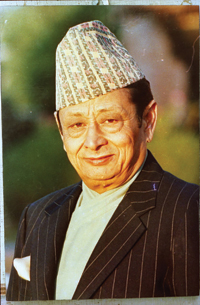
The late Ram Shanker Shrestha
Now, coming to the hotel in question – what makes it so special besides the abovementioned events? Two things in particular. First, it was originally a durbar (palace) of Agni Shumsher Jung Bahadur Rana, father of Queen Aishwarya and her two sisters, the erstwhile Queen Komal and Princess Prekshya. According to Managing Director Binod Shanker Shrestha (Ram Shanker’s son), all three were born in the durbar. One can well visualize the three playing around in the courtyard as little girls! The second thing that makes it special is that it was renovated into a hotel without changing its basic character, that of a Rana palace, by a man who had till then been just running a modest hotel (Hotel Green) in New Road, that too under lease.
Ram Shanker passed away in 1987 leaving behind a legacy for his son Binod to live up to. Front Desk Manager Bijay Man Shrestha, who has been with the hotel for the last 33 years, says this about Ram Shanker, “He was very involved in the tourism sector and close to both King Birendra and King Gyanendra. He was once the Vice President of the Hotel Association of Nepal and was nominated by King Birendra as a Member of the then Rastriya Panchayat. In this capacity, he drew up a master plan for Nepal’s tourism development.” So, where is this master plan? Was it ever implemented? “I don’t know where it has been dumped,” answers Bijay Man with a rueful smile. Similar is the response from Binod Shanker who says, “The plan was made in association with a German expert, I don’t remember his name now, but I really don’t know about what happened to the plan.” Seeing that it is after all a Nepal Tourism Year, one cannot but help thinking that perhaps it would have been helpful to our present day planners as well. However, since neither the Managing Director knows about its whereabouts nor does Bijay Man, one has to surmise that it must be gathering dust in some dank dark corner in some government office.
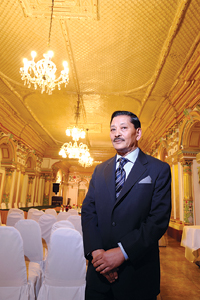
MD Binod Shanker Shrestha
Nevertheless, Bijay Man does remember Ram Shanker making sketches on long rolls of paper while construction of the Kailash Hall was underway. “Yes, all these lovely designs you see in the interiors were Ram Shanker’s idea.” Indeed, this historically important hall has to be seen firsthand to truly understand how grandiose it is. “During the 4-5 days of the Colombo Plan conference, it was jam packed,” remembers Bijay Man. Seating in the hall today, one can imagine the host of dignitaries including many heads of state present at the conclave, and one can imagine too what must have been going through their minds since for many of them it could well have been a first visit to Nepal. The setting itself could have been an impressive introduction to the country’s ancient history and culture.
Celebrities galore
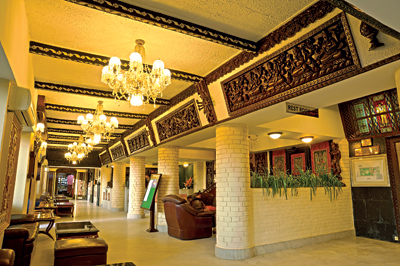
The lobby is decorated with many finely carved pieces in wood
For Hotel Shanker too, it was the first time that they had hosted such a big event. And expectedly, it was the beginning of many more equally important occasions it would be hosting in the future. Bijay Man reveals, “President Giani Zail Singh of India had a press conference in this hall as did Indian Prime Minister Narasimha Rao. Similarly, President Zia Ul Haque of Pakistan and Foreign Secretary Henry Kissinger of America too held there press conferences here.” Numerous VIPs including many personalities from the Indian film industry have stayed in the hotel. Binod Shanker’s sister, Baiju, who manages the housekeeping at the hotel, names a few, “I can remember Prem Nath, Daisy and Honey Irani, Tun Tun, and yes, Dev Anand who has come here three times, beside well known producers like O P Nayar and Nasir Hussain.” She also remembers Salman Khan pretending to fall down the stairs into the lobby while shooting for a film. Prina, the Managing Director’s daughter, discloses that the famous singer Sting also stayed in the hotel once. “I think he was travelling incognito but somehow a local daily came to know about it and soon there was a big crowd outside. I don’t think Sting liked that. Even when we requested a photo with him, he seemed quite reluctant although he did agree seeing that we were the hotel’s owners!”

The finely detailed work in the Kailash Hall is reminiscent of age old durbars
Yes, Hotel Shanker has seen its fair share of celebrities and these have also included many well known mountaineers. According to Prajwol Shanker, “Reinhold Messner (the first climber to have climbed Everest without use of bottled oxygen) has stayed here a couple of times but it’s been a long time now since he’s come again.” Bijay Man remembers Tenzing Norgay Sherpa, the first conqueror of Everest, staying at the hotel too. According to him, they receive many return guests and these are mostly from European countries like Germany, Britain and France. Perhaps it is because of the feeling of living in a palace that draws them so, but it could be equally the warmth of the welcome they receive at this hotel which is so unlike the stereotype environment in many five star hotels. Shanker Hotel has presently 94 rooms, which is not that many in comparison to other similarly high standard hotels. Now, this wasn’t always the case.
The beginnings
Bijay Man says, “I joined in 1974 and at that time there were 135 rooms.” So what happened? A fuller explanation is given by Managing Director Binod Shanker, “We took the property under lease and had the hotel inaugurated by Prince Himalaya in November 1964. At that time it had only 23 rooms. Then we started to renovate the building to construct more rooms.” Originally a three storied durbar, it was decided to add more floors to make it five storied. The high ceilings were taken advantage of when doing so, so that an original floor could easily be appropriated into two. Binod Shanker continues, “It was a time-consuming affair and we had to take special permission from the government since it was close to the royal palace and there were issues of security involved.” Came a time soon enough when they were told to stop construction. One can only guess as to how much of a turmoil it must have caused to the hoteliers involved. But then, fate intervened in the form o
f King Birendra’s coronation. “We were told to go ahead with our work,” smiles Binod Shanker. Obviously, the government (and royalty) must have realized that there weren’t many, if any, good hotels in the capital to house all the VIP guests expected!
There is also another twist in this tale. Prajwol Shanker reveals, “Actually, the royal family could have taken our hotel as an experimental study to see how a hotel was run because, as the renovation of our hotel was going on, two other hotels, namely Soaltee and Annapurna (both having royal interests) were also being built. I think they wanted to learn from us on how to run a big hotel.” Was Hotel Shanker then the first ‘real’ hotel in the capital? “You could say that,” says Bijay Man, “although Boris’s Royal Hotel and another, Coronation Hotel, were also there. Both of course have been out of business for a long time now.”
Coming back to how the hotel’s rooms came down to 94 today from 135 in 1977, Binod Shanker says,
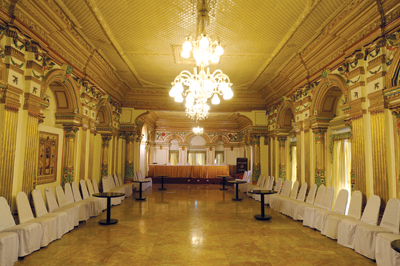
The chandeliers add to the grandeur - they were brought from Belgium
“After renovations were completed, we had an additional 79 rooms thus making a total of 102 rooms when added to the original 23. However, due to the need to create some needed space, we had to sacrifice 8 rooms, so, that is how we have 94 rooms today.” But, what about the 135 rooms in 1977 as mentioned by Bijay Man? Well, seeing as to how we are talking about a 100 year old durbar after all, things have to be a little complicated, it seems like. Now, to clear this confusion, we have to delve into the beginning that is, the purchase itself.
And, who better than Binod Shanker to clarify matters? He explains, “The property was owned by four stakeholders. At first, we leased two wings from Agni Shumsher. Then likewise, we leased another two wings from his son Keshab Shumsher and his wife Tirtha Rajkumari. Next, we took on lease another wing owned by Kendra Shumsher, the other son of Agni Shumsher. We purchased the whole property in 1977 except for the wing owned by Kendra Shumsher which was leased for another 15 years. It had 39 rooms. Unfortunately, when the lease ran out and we wanted to buy it outright, we couldn’t come to a mutually agreeable settlement. This wing thus had to be let go and in due time, the Finance Ministry bought it and it is now the Internal Revenue and VAT office.”
A lost opportunity
Prajwol Shanker however has a different take on this, “That was actually the best part of the hotel. All of the 39 rooms had south facing windows so that they received plenty of sunlight. I believe that when the lease ran out, the tourism scenario was not looking very good in the country and added to that, the fact that both parties couldn’t agree on a financial settlement, made my Dad sacrifice the property.” Whatever the case may be, it was indeed a terrible thing to have happened because even today when one looks at the whole durbar, one can easily judge that having this particular wing intact would have added much to Hotel Shanker’s glory. Which is not to say that it is not glorious as it is today, but from an aesthetic point of view (and financial too, if we are to calculate the rate at which real estate prices have rocketed since those days particularly in such a prime location as Lazimpat) the whole would have been so much better to look at. However, they did the next best thing and bought the adjoining properties on the other side. Prajwol says, “We also have quite a big plot behind the hotel.”
An interesting aside here is the reason for Agni Shumsher’s family to sell the premises in the first place. One could question as to why such a well established family of such high standing had felt the need to sell their ancestral property. Binod Shanker has the answer to this perplexing question. He says, “At that time, Agni Shumsher had taken on a large contract to supply the army’s rations. Apparently, it was not a successful venture and ultimately, the army had no choice but to take out a notice for auctioning the property. We came to a

The stained glass on the door of the Durbar Hall is a reminder of an age gone by
private arrangement with Agni Shumsher’s family to take over the property on a lease basis.” One can conclude that Agni Shumsher’s family must have felt relieved not to have had a public auction which would have been obviously humiliating.
A promising future
This aside, and coming to the present, the fact that the hotel has plenty of free space is cause for succor since they already feel the need to expand. According to Baijju, Binod’s sister, “We need at least another 100 rooms.” This in itself is a statement that signifies Hotel Shanker’s success as a business entity. In fact, according to Binod Shanker, “Business in 2010 was very good.” This, in spite of the many problems throughout the country in the year gone by along with the worldwide recession, can mean only one thing and that is, Hotel Shanker has become hugely popular among tourists abroad. Binod Shanker shows a couple of sketches done by a local architectural firm. “These are the planned extensions next to the Kailash Hall. We will start constructions soon.” Apparently, in addition to rooms, the demand for well serviced space to host banquets, conferences and so on is so great at the hotel that they have been feeling the need for more halls like Kailash on the premises for quite some time now. The Kailash Hall and the smaller but equally ornately designed Durbar Hall and its neighbor, the One Eyed Hall, on the first floor, are on most days, busy hosting one event or the other. In addition, besides professional and cultural gatherings, wedding parties are also a big thing at the hotel. Bijay Man validates this, “We are already booked till March-end for marriage receptions.” Prajwol Shanker adds another aspect to this, “There is also a growing tendency among NRNs (Non Residential Nepalis) to have their weddings back home and many of them prefer to have it on our gardens.

A life sized decoratiive mirror that is said to be 400 years old
In fact, out of the approximately 35 ropanis (4.4 acres) of the property, almost one third is landscaped space including a large well manicured garden with a lovely new swimming pool in front that has been designed to mix well with the neo classical architecture of the hotel itself. Speaking of the need for more rooms as well, Binod Shanker says, “Right now too, we are already facing room shortages during the months of September, October and November as well as in March and April. What we see is that when we have no vacancies, similar is the case in most hotels nearby. Sometimes we have had to arrange rooms as far away as in Godavari for guests! That’s why we are planning on constructing at least 100 more rooms on the premises.” So, does that mean a change in the hotel’s architectural character? “No,” says the Managing Director. “We will not be changing anything in this hotel. We might use the space behind.” This is a welcome commitment from one who has been entrusted to carry a legacy forward. He does add however, “Of course we have had almost five renovations done so far, you know - the toilets, furnishings, wiring, and so on.”
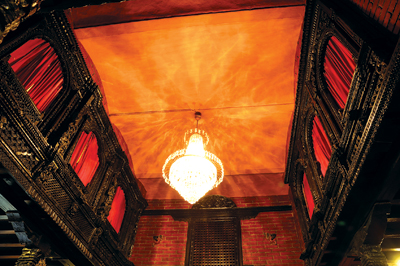
Many large Newari wooden windows crowd the Kunti Bar
Carrying the torch
One can see that he is immensely proud of what Hotel Shanker stands for and come what may, he is going to carry the torch that his father Ram Shanker has handed to him as will undoubtedly, his sons Prajwol and Prabhu, with help from their sister Prina and Aunt Baijju. And, of course, the support of the 100 plus friendly employees including long time ones like Bijay Man, the Front Desk Manager, Jujubhai, the in-house carpenter and bell boy Kumar who have served the hotel right from the very beginning. All this goes to make Hotel Shanker a hotel with perhaps the friendliest environment among major hotels here, notwithstanding its regal nature and its four star ranking.
Tha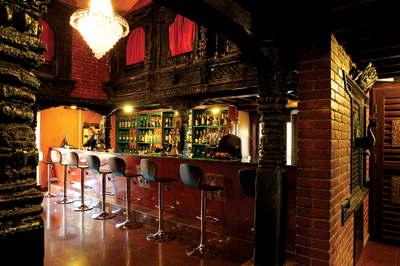 t is why one has to assume that it was not only because of its proximity to the royal palace that King Birendra used to have his birthday parties celebrated with friends at Hotel Shanker, or why even the Queen Mother has visited to have lunch at its Kailash Restaurant; or why the princes Dipendra and Paras too frequented the hotel. One has to assume that the hospitable nature of the hotel itself could have played a big part in attracting them to enjoy its facilities. And, one can also presume that it is this that makes guests who have stayed here once, come back again every time they next visit Nepal. Hotel Shanker has the kind of ambience that makes one feel at home even when having the experience of living in a palace. This is the uniqueness of Hotel Shanker. A uniqueness carefully nurtured through three generations. A uniqueness maintained by not bending with the times or compromising on its basic identity.
t is why one has to assume that it was not only because of its proximity to the royal palace that King Birendra used to have his birthday parties celebrated with friends at Hotel Shanker, or why even the Queen Mother has visited to have lunch at its Kailash Restaurant; or why the princes Dipendra and Paras too frequented the hotel. One has to assume that the hospitable nature of the hotel itself could have played a big part in attracting them to enjoy its facilities. And, one can also presume that it is this that makes guests who have stayed here once, come back again every time they next visit Nepal. Hotel Shanker has the kind of ambience that makes one feel at home even when having the experience of living in a palace. This is the uniqueness of Hotel Shanker. A uniqueness carefully nurtured through three generations. A uniqueness maintained by not bending with the times or compromising on its basic identity.
At the same time, even a hotel such as Shanker cannot always please everybody as shown by this account by Bijay Man, “Once, a Kuwaiti prince stayed here with a few friends. They had come by chartered jet from Bombay (now Mumbai). I did all I could to make their stay interesting and showed them the sights including the magnificent temples around Kathmandu. They were not at all impressed. On the second day, they told me that they were bored in Kathmandu – they were more interested in nightlife of which there was none at all. They said that they preferred to return to Bombay which had a better nightlife and this is what they did after three days here.” Well, like mentioned before, even a great place like Hotel Shanker has to lay down the gloves sometimes!
For further information, Hotel Shanker's official site is: http://www.shankerhotel.com.np









